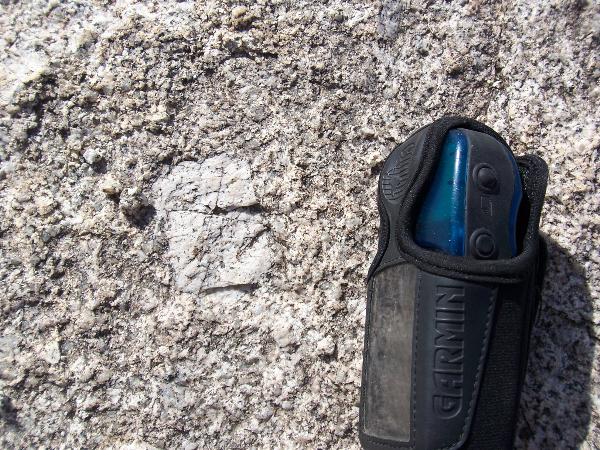
 The coordinates bring you close to the apex of a relatively wide dome. The core of the dome is made of granite. Granite is a rock formed from magma rich in light colored feldspar and quartz that cools very slowly deep below the ground (see USGS for a graphic of the various compositions of magma). This slow cooling allows crystals of each mineral to grow large and interlock.
The coordinates bring you close to the apex of a relatively wide dome. The core of the dome is made of granite. Granite is a rock formed from magma rich in light colored feldspar and quartz that cools very slowly deep below the ground (see USGS for a graphic of the various compositions of magma). This slow cooling allows crystals of each mineral to grow large and interlock.
This magma formed in the Mezazoic (approximately 80 to 180 million years ago). Prior to this time, the North American plate had been pushing the Farallon Plate to the west down into the mantle in a process called subduction. As the plate was pushed down it melted forming large amounts of magma that moved up through weak areas along the edge of the North American Plate. When the entire Farallon Plate had been subducted, the magma began cooling into this large grained plutonic rock forming the granite of Cima Dome.
 Erosion then began removing the layers of rock above the granite exposing it directly to the surface. The minerals mica and fedspar common in granite degrade to clay. Clay is a material that expands when it gets wet and contracts when it dries, much like freezing water. This process slowly breaks apart the granite into the sandy soil that the largest and densest Joshua Tree Forest in the world grows.
Erosion then began removing the layers of rock above the granite exposing it directly to the surface. The minerals mica and fedspar common in granite degrade to clay. Clay is a material that expands when it gets wet and contracts when it dries, much like freezing water. This process slowly breaks apart the granite into the sandy soil that the largest and densest Joshua Tree Forest in the world grows.
Logging requirements:
Send me a note with :
- The text "GC13END Cima Dome" on the first line
- The number of people in your group.
- The size of the individual grains you find the granite outcrops of Cima Dome;
- Compare the size and mineral types (go by color if you can't identify minerals) of the sand grains in the soil and the rock outcrop. What differences are there?
Please begin your e-mail with the name of the earthcache and make sure your log includes the number of people in your group.
The above information was compiled from the following sources:
- Cima Dome, Granite Mountains,; Geology of Mojave National Preserve, USGS, http://www2.nature.nps.gov/geology/usgsnps/mojave/cima1.html http://www2.nature.nps.gov/geology/usgsnps/mojave/cima2.html http://www2.nature.nps.gov/geology/usgsnps/mojave/grmtn1.html http://volcanoes.usgs.gov/Products/Pglossary/VolRocks.html
Placement approved by the
Mojave National Preserve